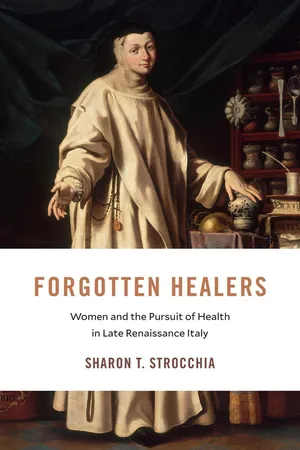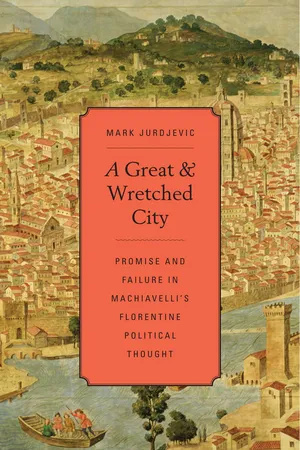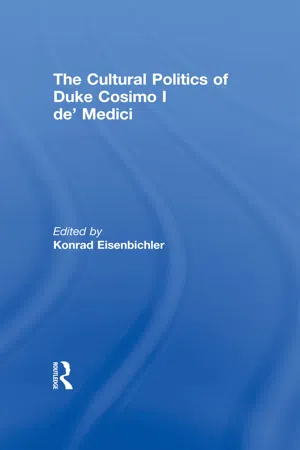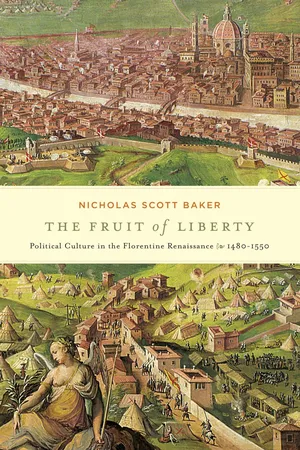History
House of Medici
The House of Medici was a powerful Italian family that rose to prominence in the 15th century, becoming one of the most influential and wealthy dynasties in Europe. They were known for their patronage of the arts, banking prowess, and political maneuvering, playing a significant role in the cultural and political landscape of Renaissance Florence.
Written by Perlego with AI-assistance
Related key terms
6 Key excerpts on "House of Medici"
- eBook - ePub
Forgotten Healers
Women and the Pursuit of Health in Late Renaissance Italy
- Sharon T. Strocchia(Author)
- 2019(Publication Date)
- Harvard University Press(Publisher)
In 1532, the centuries-old Florentine republic was replaced by a dynastic principate, led by Duke Alessandro de’ Medici. Although Florence quickly became one of the principal courts of Renaissance Europe, the Medici were still newcomers to the dynastic stage when seventeen-year-old Cosimo I de’ Medici (1519–1574) assumed the ducal throne following the assassination of his predecessor in 1537. Cosimo’s immediate hire of Andrea Pasquali as court physician showed his ability to build a regime that was both separate from the republican past yet continuous with it. The doctor’s long service at the Florentine civic hospital of Santa Maria Nuova gave him strong republican credentials, while his more recent attendance on the murdered duke indicated his openness to new political loyalties. 7 Regular medical staff remained limited throughout most of Cosimo’s reign, especially by comparison with more established Italian courts. 8 Facilitating this fraught political transition were two Medici women: Cosimo’s mother, Maria Salviati (1499–1543), and his Spanish-born wife, Eleonora of Toledo (1522–1562). Much has been written about them as political figures and cultural patrons, but their medical agency has barely been explored. Both women exercised enormous influence over daily care routines and critical decision-making processes, which brought them into frequent interaction with court physicians and other practitioners. Yet their personalities were a study in contrasts. Granddaughter of Lorenzo the Magnificent, Salviati was renowned for her piety, modesty, and sharp political instincts. In 1516, at the age of seventeen, she married the popular military captain Giovanni de’ Medici (later called delle Bande Nere). Widowed ten years later, Maria began grooming her only child, Cosimo, as the rightful heir to Medici political ambitions - eBook - ePub
- Eileen Hooper Greenhill(Author)
- 1992(Publication Date)
- Routledge(Publisher)
3 The palace of the prince
The Medici Palace combined in a new way earlier practices, including the treasure gathering of the medieval princes, and the newer practices of collecting classical things (for example, sculpture, manuscripts, fragments of buildings, and coins) which emerged as scholarly interest turned very slowly to the past of ancient Greece and Rome. These two elements combined within a shift in the practices of patronage from the older, public, religious forms where buildings or works were commissioned, often by groups of patrons, to glorify God, to a newer form that was private, singular, secular, and dedicated to the glory of man, specifically the patron. Although the two forms ran together in fifteenth-century Florence for some time, the emergence of the newer practices constituted subject positions that positioned families like the Medici in new relations of advantage/disadvantage, as more wealthy, more powerful, more knowledgeable than their fellow merchants. By establishing themselves in this higher social position, they established themselves, within a hierarchised universe, as more worthy than their former peers, thereby legitimising their unconstitutional rule.Shifts in the practices of collecting and of patronage articulated with new attitudes to the past, and with older understandings of the nature of the universe as the creation of a supernatural being. Material things were made meaningful within this complex discourse of multifaceted and often contradictory factors.Meanings articulated were in constant movement. Changes in the field of possibilities, which included political changes, changes in the operation and management of the Medici banks, wars, shifts in trading patterns, deaths, movements of finances, as well as cultural changes, led to a constant oscillation of meaning and practices within the Medici Palace. Considerable changes of all sorts can be identified during the fifty-year period under discussion. - eBook - ePub
- Mark Jurdjevic(Author)
- 2014(Publication Date)
- Harvard University Press(Publisher)
Histories showed in detail, they were prepared to support the family so long as Medici authority served various specific and hence conditional ends or so long as they feared challenges to their position. Whenever such ends were met or such fear was absent, however, they would use their privileged position in all of the government’s major councils to undermine the family whose exceptional status they resented. Worse, because of that structural flaw, the family was obliged routinely to resort to the rough tactics of fear and terror to enforce discipline, thereby ensuring that the undercurrent of resentment in their ranks would and could by definition never disappear or be harmoniously resolved. This in turn implied further acts of terror and intimidation.But what of the regime’s merits? Given its serious flaws, what enabled it to survive for longer than any other regime analyzed in either the Discourse on Florentine Affairs or the Florentine Histories?One important source of the regime’s durability was the exceptional skill, talent, and charisma of Cosimo and Lorenzo, without whom Medici power would have likely been no more or less remarkable than that possessed earlier by Maso and Rinaldo degli Albizzi or by Corso Donati before them. Even while condemning the general nature of their regimes, Machiavelli in the Histories frequently praised the talent, instincts, and political style of those two illustrious fifteenth-century Medici.23 As Najemy has shown, Machiavelli’s rhetorical praise of the Medici was not false but part of a sincere and substantive distinction he made between the positive merits and accomplishments of individual Medici and the overall negative impact of their regime on Florentine history.24 As Machiavelli himself put it, in spite of his description of “the probity of Giovanni, the wisdom of Cosimo, the humanity of Piero, and the magnificence and prudence of Lorenzo,” his narrative was nevertheless “far from all flattery.”25 - Konrad Eisenbichler(Author)
- 2017(Publication Date)
- Routledge(Publisher)
Chapter 5 Lessons from the Past: the Palazzo Medici as Political ‘Mentor’ in Sixteenth-Century Florence Roger J. CrumIn 1537 Cosimo I de’ Medici, then seventeen years old, became duke of Florence and set up residence in the fifteenth-century Palazzo Medici on the Via Larga (figure 5.1 ). Three years later he left the palazzo with his new wife and infant daughter for the Florentine city hall, the Palazzo della Signoria (figure 5.2 ). Cosimo deemed this building, today more commonly known as the Palazzo Vecchio, as more suitable as his residence; in fact, it had ‘regal rooms,’ as he proudly explained in a letter to his father-in-law Pedro de Toledo, the Spanish Viceroy of Naples.1 Cosimo’s court historian, Giambattista Adriani, went one step further in attaching significance to Cosimo’s selection of a new residence. The move, he wrote, showed that ‘Cosimo was the absolute monarch and arbiter of the government.’2 So Cosimo left the Palazzo Medici behind as a relic – perhaps even an albatross – of the republican past of Florence and of the constraints that that past had placed upon the Medici and their designs to rule the city and its dominion.Modern scholars have similarly relegated the palazzo to the earlier moment in Florentine history; this is true even though the history of its Medici habitation is almost equally spread between the fifteenth and sixteenth centuries.3 In our minds, however, the Medici of the sixteenth century are more identified with closing the palazzo up and leaving it behind for good. This closing up began as early as c. 1518 when Michelangelo effectively eliminated the original ground-level loggia of the palazzo with the installation of dressed masonry and his famous ‘kneeling’ windows; it was completed in 1540 when Duke Cosimo moved himself and his family to the Palazzo della Signoria. The installation of Michelangelo’s windows was ordered by the Medici during a period, soon after their restoration in 1512, when the indefinite continuation of their rule in Florence was uncertain.4 It was, in a sense, a defensive move. In contrary fashion, the move to the Palazzo della Signoria in 1540 represented a transference of confidence and a definite step toward the seamless identification of the Medici with the city of Florence. It is clear, then, that these closures actually tell us much about the position and self-positioning of the Medici in the city. But can we not look beyond these closures for a meaningful conjunction of the Medici and the Palazzo Medici in the sixteenth century? In this article, I would like to challenge the notion that residential meaning for the Palazzo Medici is limited to the fifteenth century by discussing Cosimo’s three-year residency in it, a period that led to his move of confidence to the Palazzo della Signoria. It is my argument that this residency probably represented not a period of dormancy for Cosimo, but one of informative transition during which time he learned from the Palazzo Medici. As his ‘mentor,’ the Palazzo Medici would likely have provided Cosimo with valuable lessons on the connections between the rule of a state and the practice of art and architectural patronage. The theme of this volume is the cultural politics of Cosimo I de’ Medici. In my contribution I propose that Cosimo’s acculturation into the visual dynamics of Florentine politics must literally have begun at home, or rather his first administrative home within the walls of the Palazzo Medici. Patricia Rubin recently observed that in the 1550 edition of his Lives,- eBook - ePub
- Paul Strathern(Author)
- 2016(Publication Date)
- Pegasus Books(Publisher)
The economic depression of the early 1340s was followed by the catastrophe of the Black Death. This arrived in Europe from China, by way of Genoese ships from the Black Sea, in 1347. Contemporary chroniclers, confirmed by recent research, record that during the next four years around one-third of Europe’s population was wiped out by the plague. Owing to bad sanitation and ignorance of how the disease spread, the situation was worst in the cities, where families suspected of having the plague were sometimes simply bricked up in their homes and left to die. Those who could afford to do so fled from Florence into the surrounding Tuscan countryside; of those who remained behind, well over half perished. Not surprisingly, the first stirrings of the new humanism were quickly replaced by superstitious morbidity; yet the comparative social stasis of medieval Europe had begun to crumble, and fundamental change was inevitable.The Medici family in Florence had by now expanded to include some twenty or thirty nuclear families. The affiliation of these families, recognisable by name, would have been looser than that of a single family, more akin to that of a clan, with its own internal rivalries but overall group loyalty. The Medici appear to have taken advantage of the vacuum left by the bankruptcy of the three leading Florentine banking families, with several Medici going into banking, establishing their own separate small enterprises. Brothers or cousins would have joined together as partners to provide shares of the original capital, often working together in the daily running of the bank, which would have involved such business as foreign-currency exchange, small deposits, and seasonal loans to wool traders, weavers and the like. At least two of these enterprises were sufficiently canny, or lucky, to survive the economic ravages of the Black Death, and were thus able to consolidate the Medici power base. The Medici now provided the city with more than the occasional gonfaloniere - eBook - ePub
- Nicholas Scott Baker(Author)
- 2013(Publication Date)
- Harvard University Press(Publisher)
Two decades later, Francesco Vettori would pinpoint this attitude as a potential weakness for exploitation by those wishing to alter the Florentine stato, because “the majority of men … will stay on the corner to watch the game” rather than getting involved in active resistance to any political changes. 84 The political concerns of this majority would appear to have embraced the preservation of their own personal position as well as that of the office-holding class more generally. 85 In October 1512, Luigi Guicciardini observed that “the universale, having seen the liberality and humanity of the Medici, are confident and have the greatest hope they will go from good to better.” 86 This depended upon the continued independence of Florence: on the preservation of the city’s honor and health. Rather than resulting from ideological or partisan loyalties, the acceptance of the return of the Medici in 1512 for most of the office-holding class arose from a perception that the policies of Soderini’s administration had threatened the sovereignty and survival of Florence, the same concerns that had fostered the coup d’état against the Medici in 1494. The place of the Medici themselves within the government and the office-holding class altered substantially in the years after 1512 from their role during the fifteenth century. While never dominating the most significant offices of the republic in a manner commensurate with the actual influence they possessed, the leading members of the Medici family had consistently sat on various magistracies of the government between 1434 and 1494. Cosimo il Vecchio sat as gonfaloniere di giustizia in 1434, 1438, and 1445, on the Sedici in 1450, on the Consuls of the Arte del Cambio in 1436, and served as an accoppiatore in 1440. His son Piero sat on the Signoria in 1448, on the Mercanzia in 1465, on the Consuls of the Arte di Calimala in 1468, served as gonfaloniere in 1460 and as an accoppiatore in 1448 and 1452
Learn about this page
Index pages curate the most relevant extracts from our library of academic textbooks. They’ve been created using an in-house natural language model (NLM), each adding context and meaning to key research topics.





